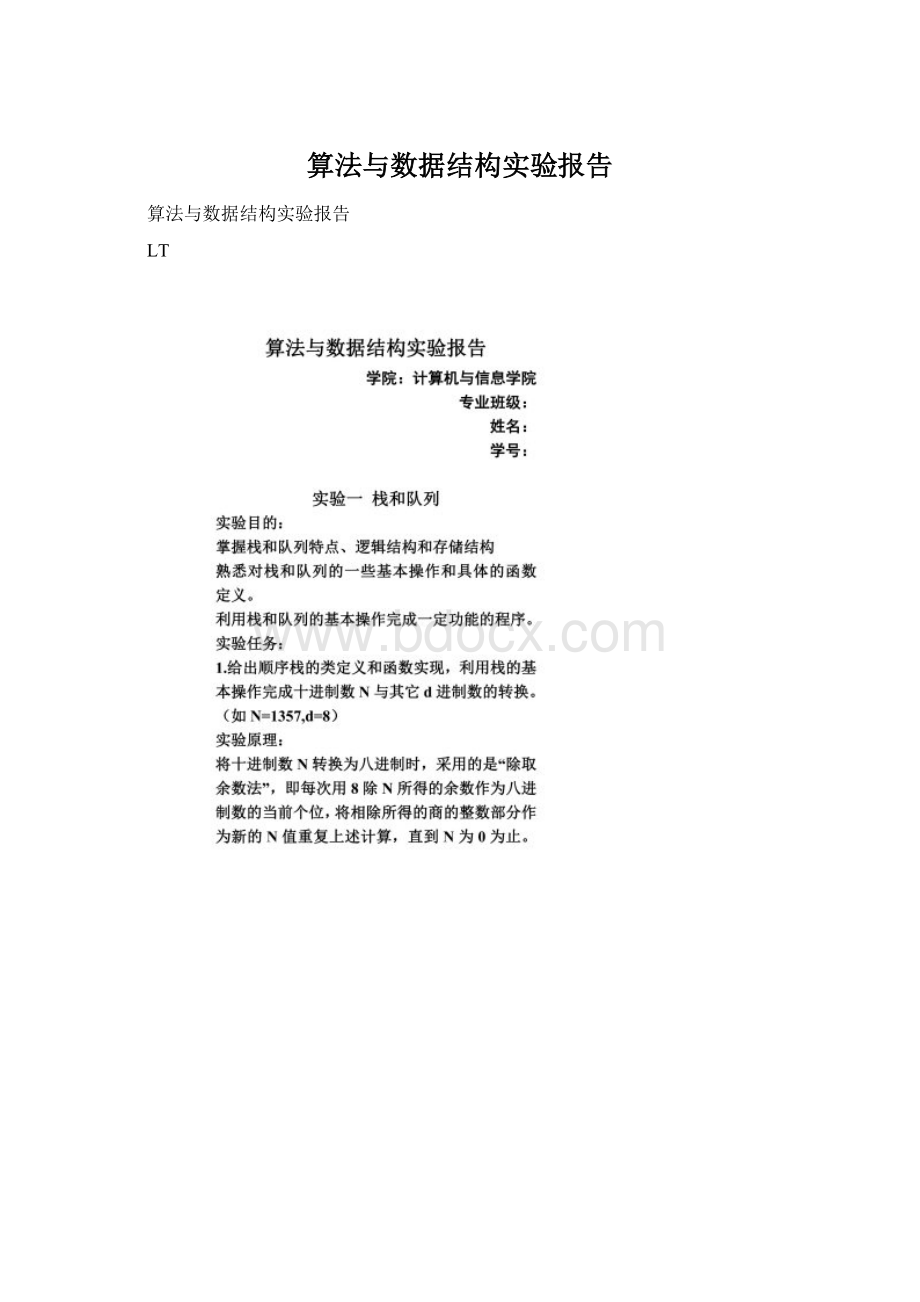算法与数据结构实验报告.docx
《算法与数据结构实验报告.docx》由会员分享,可在线阅读,更多相关《算法与数据结构实验报告.docx(48页珍藏版)》请在冰豆网上搜索。

算法与数据结构实验报告
算法与数据结构实验报告
LT
DATA_TYPEdata[MAXLEN];
intcount;
};
stack:
:
stack()
{
count=0;
}
boolstack:
:
empty()const
{
returncount==0;
}
error_codestack:
:
get_top(DATA_TYPE&x)const
if(empty())
returnunderflow;
else
{
x=data[count-1];
returnsuccess;
}
}
error_codestack:
:
push(constDATA_TYPEx)
{
if(full())
returnoverflow;
else
{
data[count]=x;
count++;
}
}
error_codestack:
:
pop()
{
if(empty())
returnunderflow;
else
{
count--;
returnsuccess;
}
}
boolstack:
:
full()const
{
returncount==MAXLEN;
}
voidmain()
{
stackS;
intN,d;
cout<<"请输入一个十进制数N和所需转换的进制d"<cin>>N>>d;
if(N==0)
{
cout<<"输出转换结果:
"<}
while(N)
S.push(N%d);
N=N/d;
}
cout<<"输出转换结果:
"<while(!
S.empty())
{
S.get_top(N);
cout<S.pop();
}
cout<}
while(!
S.empty())
{
S.get_top(x);
cout<S.pop();
}
}
测试数据:
N=1348d=8
运行结果:
2.给出顺序队列的类定义和函数实现,并利用队列计算并打印杨辉三角的前n行的内容。
(n=8)
实验原理:
杨辉三角的规律是每行的第一和最后一个数是1,从第三行开始的其余的数是上一行对应位置的左右两个数之和。
因此,可用上一行的数来求出对应位置的下一行内容。
为此,需要用队列来保存上一行的内容。
每当由上一行的两个数求出下一行的一个数时,其中
的前一个便需要删除,而新求出的数就要入队。
程序清单:
#include
#include
usingnamespacestd;
typedefintDATA_TYPE;
constintMAXLEN=100;
enumerror_code
{
success,underflow,overflow
};
classqueue
{
public:
queue();
boolempty()const;
error_codeget_front(DATA_TYPE&x)const;error_codeappend(constDATA_TYPEx);error_codeserve();
boolfull()const;
private:
intfront,rear;
DATA_TYPEdata[MAXLEN];
};
queue:
:
queue()
{
rear=0;
front=0;
}
boolqueue:
:
empty()const
{
return(front%MAXLEN==rear%MAXLEN);
}
error_codequeue:
:
get_front(DATA_TYPE&x)const{
if(empty())
returnunderflow;
else
{
x=data[front%MAXLEN];
returnsuccess;
}
}
error_codequeue:
:
append(constDATA_TYPEx){
if(full())
returnoverflow;
else
{
data[rear%MAXLEN]=x;
rear++;
}
}
error_codequeue:
:
serve()
{
if(empty())
returnunderflow;
else
{
front++;
returnsuccess;
}
}
boolqueue:
:
full()const
{
return((rear+1)%MAXLEN==front);}
voidmain()
{
queueQ;
intnum1,num2;
inti=0;
cout<<1<Q.append
(1);
num1=0;
num2=1;
for(i=0;i<=7;i++)
{
intj=0;
intk=0;
num1=0;
for(j=0;j<=i;j++)
{
Q.get_front(num2);
Q.serve();
cout<Q.append(num1+num2);
num1=num2;
}
cout<<1<Q.append
(1);
}
}
运行结果:
3.给出链栈的类定义和函数实现,并设计程序完成如下功能:
读入一个有限大小的整数n,并读入n个数,然后按照与输入次序相反的次序输出各元素的值。
实验原理:
依次将栈中的元素出栈,因为栈的一个特点就是先进后出,这样,当将原栈为空时,输出与输入次序相反,从而实现了本题的要求。
程序清单:
#include
#include
usingnamespacestd;
typedefintDATA_TYPE;
typedefstructLNode
{
DATA_TYPEdata;
LNode*next;
}LNode;
enumerror_code
{
range_error,success,underflow
classlinkstack
{
public:
linkstack();
~linkstack();
boolempty()const;
error_codepush(constDATA_TYPEx);
error_codeget_top(DATA_TYPE&x)const;
error_codepop();
private:
LNode*top;
intcount;
DATA_TYPEdata;
};
linkstack:
:
linkstack()
{
top=NULL;
count=0;
}
boollinkstack:
:
empty()const
{
return(count==0);
}
error_codelinkstack:
:
push(constDATA_TYPEx)
{
LNode*s=newLNode;
s->data=x;
s->next=top;
top=s;
count++;
returnsuccess;
}
error_codelinkstack:
:
get_top(DATA_TYPE&x)const
{
if(empty())
returnunderflow;
else
{
x=top->data;
returnsuccess;
}
}
error_codelinkstack:
:
pop()
if(empty())
returnunderflow;
else
{
LNode*u=newLNode;
u=top;
top=top->next;
deleteu;
count--;
returnsuccess;
}
}
linkstack:
:
~linkstack()
{
while(!
empty())
{
pop();
}
}
voidmain()
{
linkstackL;
intn;
cout<<"请任意输入一个整数n:
"<cin>>n;
for(inti=1;i<=n;i++)
{
L.push(i);
}
while(!
L.empty())
{
L.get_top(i);
cout<L.pop();
}
}
测试数据:
n=9i=1
运行结果:
实验二单链表
实验目的:
理解线性表的链式存储结构。
熟练掌握动态链表结构及有关算法的设计。
根据具体问题的需要,设计出合理的表示数据的链表结构,并设计相关算法。
实验任务:
1.在一个递增有序的链表L中插入一个值为x的元素,并保持其递增有序特性。
实验数据:
链表元素为(10,20,30,40,50,60,70,80,90,100),x分别为25,85,110和8。
实验原理:
给出了要插入的条件,但没有给定插入位置。
因此,需要搜索满足这一条件的插入位置的前驱结点而不是序号。
程序清单:
#include
usingnamespacestd;
enumerror_code{
success,
overflow,
underflow,
rangeerror
};
typedefintelementtype;
typedefstructLinkNode{
elementtypedata;
structLinkNode*next;
}node;
classlist{
private:
intcount;
node*head;
public:
list();
~list(){};
public:
error_codeget_element(constinti,elementtype&x)const;
node*get_head()const{returnhead;}
voidcreate();
voiddisplay();
voidinsert1(elementtypex);
};
list:
:
list(){
head=newnode;
head->next=NULL;
count=0;
}
voidlist:
:
create(){
elementtypex;node*s,*rear;
cin>>x;
rear=head;
while(x!
=-9999){
count++;
s=newnode;
s->data=x;
s->next=NULL;
rear->next=s;
rear=s;
cin>>x;
}
}
voidlist:
:
display(){
node*p;
p=head->next;
while(p!
=NULL){
cout<data<<"";
p=p->next;
}
cout<}
voidlist:
:
insert(elementtypex)
{
node*u,*P;
P=head;
while(P->next!
=NULL&&P->next->da